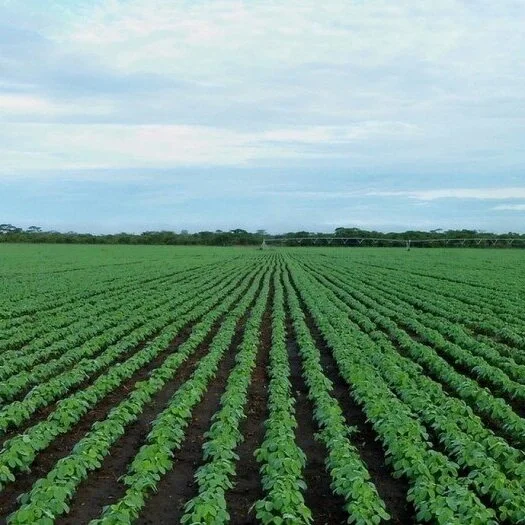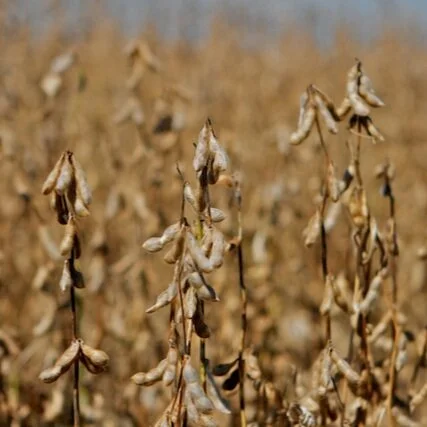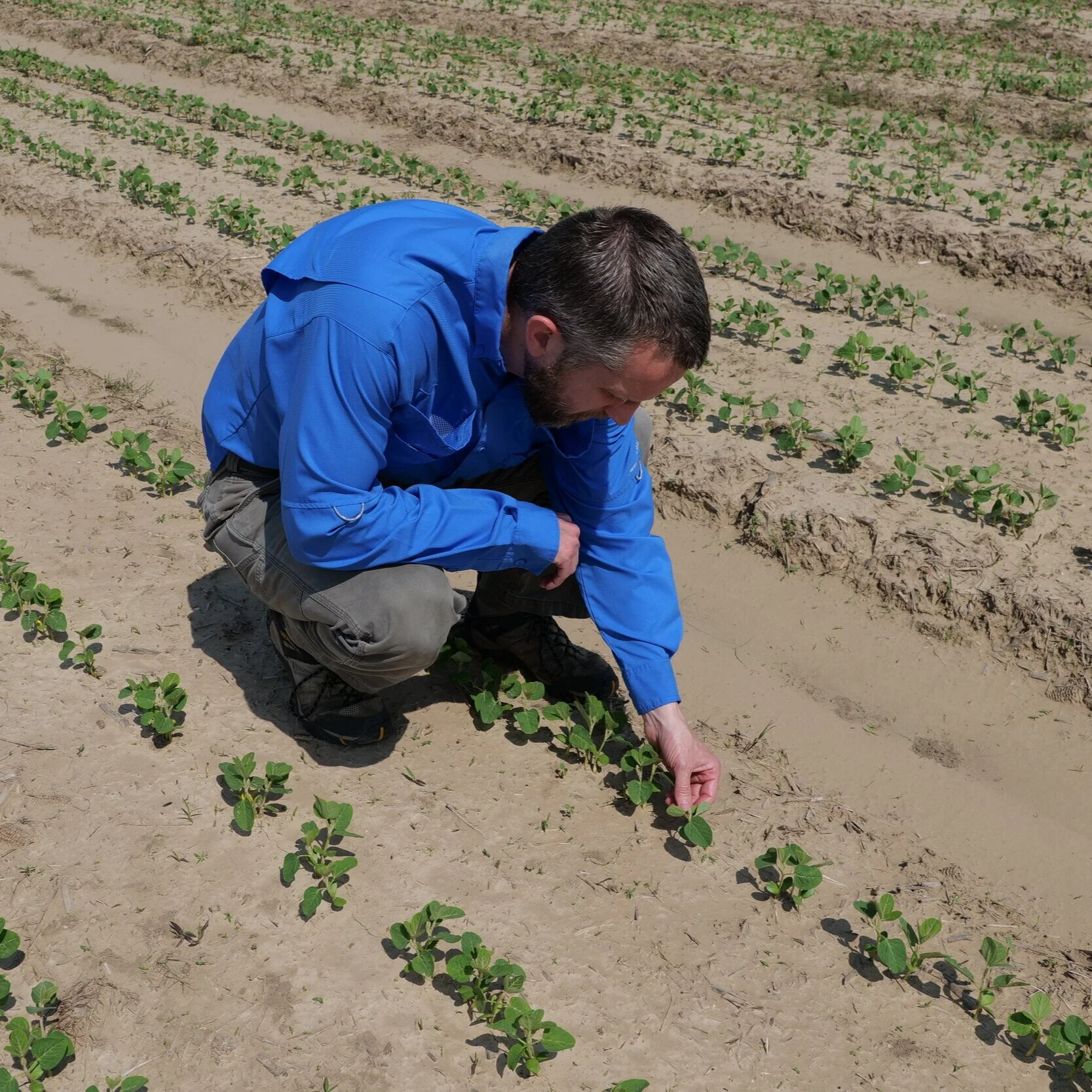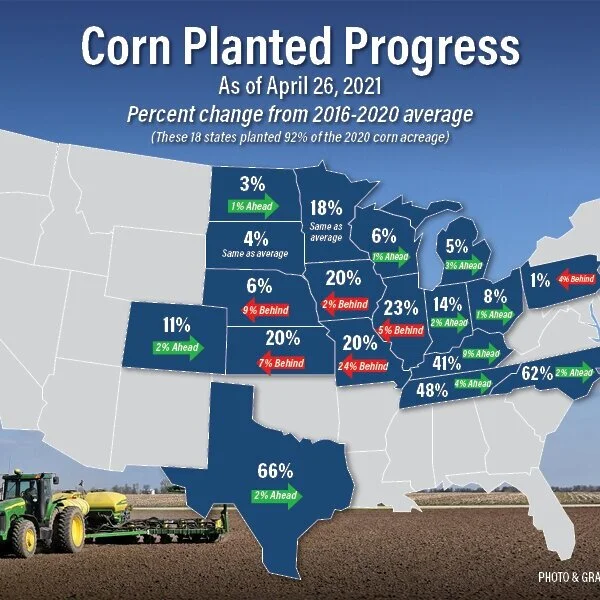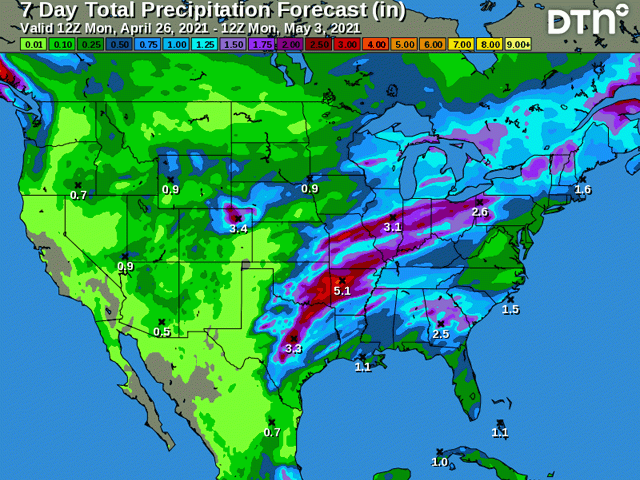The May World Agricultural Supply and Demand Estimates gives the first look at the newest marketing year demand expectations since the USDA Agricultural Outlook Forum in February. This is the highlight of spring USDA reports as it incorporates farmer planting decisions from the March Prospective Planting report and adapts supply estimates to reflect weekly planting progress reports. The big story leading up to this report is rising prices due to the increased global demand for U.S. commodities. This Market Intel dives into the May WASDE for updated estimates of the current 2020/21 marketing year crop and assesses what could be in store for the newest 2021/22 marketing year, which starts in September.
Read MoreBad weather has put Louisiana soybean farmers behind schedule, but rising prices are likely to increase acreage from last year, a Louisiana State University soybean specialist says.
Louisiana farmers have planted about 24% of the acres they plan for soybeans, compared to a 5-year average of 47% by this time, the U.S. Department of Agriculture’s National Agricultural Statistics Service reported Monday.
Read MoreWet weather and cooler temperatures have put Louisiana soybean planting behind schedule. The optimum planting date for soybeans in the state is mid-May, and growers will be hard pressed to meet this deadline. LSU AgCenter reporter Craig Gautreaux has the story.
Read MoreWhen they can, Louisiana soybean farmers have been busy planting as many acres as the weather allows. Unfortunately, many producers have not been able to get in their fields as often as they would like.
According to a May 3 report from the U.S. Department of Agriculture National Agricultural Statistics Service, approximately 24% of the state’s intended soybean acres had been planted. The five-year average for this date is 47%.
Read MorePlanting season for area crops has been “hit and miss” due to uncooperative weather, said Carol Pinnell-Alison, LSU County Extension agent.
With corn planting season complete, farmers are busy fertilizing and performing weed control between rain showers on the crop.
Area farmers planted some 98,000 acres of corn last season, up from the previous year’s total of 72,000, according to Farm Service Agency (FSA) certified acreage numbers.
Read MoreWhen considering the near-term fundamentals, the soybean market remains overbought, and a turn down in vegetable oil prices might spark a significant correction.
July soybeans have consolidated below the April 27 contract high and key reversal day.
The rally in the grain and soy markets has been led by continued dryness for the second corn crop in Brazil, which is causing significant stress. A lot of key growing areas do not have rain in the 7-day forecast, and this continues to drive the corn market higher.
Read MoreThe economic impact on direct farm-level production costs from replanting soybeans can result in an increase in the number of bushels that will be required to offset the incurred production expenses associated with replanting field operations.
The severity of this will depend on the type of soybean technology employed, as differences in the prices for seed, seed treatments and seeding rate can influence the replanting costs and, hence, the number of additional bushels required at harvest to offset those costs.
Read MoreLSU AgCenter Plant Pathologist Dr. Vinson Doyle says a fungus that has been devastating to soybeans has been identified and named by one of his grad students, Teddy Garcia Aroca. Doyle says they discovered the pathogen was probably mis-identified a long time ago.
Read MoreUp. Up. Up. May 2021 corn futures topped $7 per bushel on April 27. A look at the corn price chart shows a dramatic and consistent climb higher. You can find multi-year highs in many ag commodities.
“These are one of those times that come along generally once every 30 years or so when the markets just really take off,” says Arlan Suderman, StoneX chief commodities economist. “And we just went through this about 12 years ago or so.”
Read MoreSeptember rice futures continued higher this week along with the rest of the CBOT grains. The graphs below illustrate the price trends for the major grains since March 30, 2021. New crop corn, wheat, and soybeans have all added over $1/bu following the NASS Prospective Plantings report released on March 31.
Recall the findings from the survey resulted in limit moves higher in corn and soybeans. Corn futures have caught fire this month as estimates of Brazil’s production continue to fall. From a relative price standpoint, soybeans are losing the acreage battle to corn.
Read MoreA review and forecast of the U.S. crop weather scene begins with the impact of the cold snap during the April 21-27 week. That cold event certainly left its mark. Winter wheat in either good or excellent condition declined by four percentage points overall from the previous week to 49% rated good to excellent compared with 53% the previous week. Oklahoma and Texas showed declines in the good-to-excellent totals of 9 percentage points in Oklahoma (70% to 61%) and 10 points in Texas (28% to 18%). In addition, corn planting was slowed by the cold outbreak. Planting did advance 9 percentage points to 17% complete, but fell behind the average pace of 20%.
While corn and soybean prices continue to march higher, farmers are making progress getting the 2021 crop in the ground. The latest estimates from USDA show soybean planting progress jumped from 3% to 8% in the past week, which is trending 3% ahead of the five-year average. Around 3% of the soybean crop has emerged, which is 1% ahead of last week. Louisiana trails in planting progress, but the other key soybean production states are tracking with the five-year average or even a bit ahead.
Read MoreBloomberg writers Kim Chipman and Michael Hirtzer reported on Wednesday that, “Corn prices climbed above $6 a bushel to the loftiest level in almost eight years after the U.S. said it expects China to buy an all-time high amount of the grain off global markets.
Read MoreA new soy-based dust suppressant is now available for roads, construction sites, farms and more, offering a sustainable choice for rural, urban and business communities to improve air quality for people, pets, livestock and crops. A newly released video shows how this innovation can help reduce dust on rural gravel roads near farms nationwide.
Read MoreMidsouth soybean growers have a new management tool at their disposal. An interactive website called SoyStage uses weather data to predict soybean development based on emergence date, maturity group, and location. The site was developed by the University of Arkansas System Division of Agriculture.
Read More
